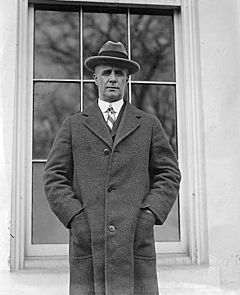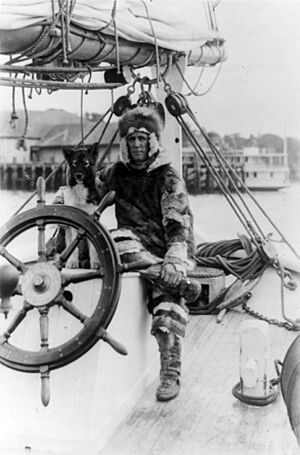Donald Baxter MacMillan facts for kids
Quick facts for kids
Donald Baxter MacMillan
|
|
|---|---|

Rear Admiral MacMillan at The White House, 1925
|
|
| Nickname(s) | Inuktitut: Nagelak, ('Leader') |
| Born | November 10, 1874 Provincetown, Massachusetts, U.S. |
| Died | September 7, 1970 (aged 95) Provincetown, Massachusetts, U.S. |
| Allegiance | |
| Branch/Service | |
| Years of service | 1918–38; 1941–45 |
| Rank | |
| Awards |
|
| Memorials | MacMillan Wharf, Provincetown, Massachusetts |
| Spouse(s) | Miriam Norton Look |
| Other work | 30 Arctic expeditions between 1908 and 1954 |
Donald Baxter MacMillan (born November 10, 1874 – died September 7, 1970) was an American explorer, sailor, and researcher. He was famous for his many trips to the Arctic, a very cold region around the North Pole. Over 46 years, he went on more than 30 expeditions.
MacMillan was a pioneer in using new technology in the Arctic. He was one of the first to use radios, airplanes, and electricity there. He also brought back many films and thousands of photos of the Arctic. He even created a dictionary for the Inuktitut language, which is spoken by the Inuit people.
Contents
Early life and education
Donald MacMillan was born in Provincetown, Massachusetts in 1874. When he was young, both his parents passed away. His father died while working as a fishing boat captain. After this, Donald moved to Freeport, Maine.
He went to Bowdoin College in Brunswick, Maine, and finished his studies in 1898. He earned a degree in geology, which is the study of Earth's rocks and soil. Before becoming a full-time explorer, he taught at Worcester Academy from 1903 to 1908.
Personal life
On March 18, 1935, Donald MacMillan married Miriam Norton Look. She was the daughter of his long-time friends. At first, MacMillan didn't want Miriam to join him on his cold Arctic trips.
However, Miriam showed him that she was strong and capable. She convinced him that she could handle the tough conditions. After that, she joined him on several of his scientific and exploration journeys to the Arctic and other places.
Arctic explorations
After teaching for five years, MacMillan became known to Robert Peary, another famous explorer. MacMillan had bravely saved nine people from a shipwreck. Because of this, Peary invited MacMillan to join his journey to the North Pole in 1908.
MacMillan had to turn back during this trip because his heels froze. But Peary later claimed to have reached the North Pole.
Crocker Land Expedition
For the next few years, MacMillan traveled in Labrador. He studied the cultures of the Innu and Inuit people. In 1913, he led an expedition to northern Greenland called the Crocker Land Expedition.
Sadly, "Crocker Land" turned out to be a mirage, which is like a trick of light that makes things appear where they aren't. The expedition members were stuck there until 1917. They were finally rescued by Captain Robert A. Bartlett on his ship, the Neptune.
The Bowdoin and early radio
After World War I ended, MacMillan joined the Naval Reserve Flying Corps. He was 44 years old, making him one of the oldest people to become an ensign in the U.S. Navy. After the war, he started raising money for another Arctic trip.
In 1921, his new ship, the schooner Bowdoin, was launched. It was named after his college. MacMillan and his crew sailed to Baffin Island and spent the winter there. This trip was special because they brought an amateur radio operator, Don Mix. He used his radio station, WNP ("Wireless North Pole"), to keep them in touch with the rest of the world. This was a big step for communication in the Arctic.
Looking for glaciers
In 1923, people were worried about a new ice age. MacMillan sailed toward the North Pole again on the Bowdoin. This time, the National Geographic Society helped fund his trip. He was looking for signs that glaciers were growing and moving forward.
Planes in the Arctic
In 1925, MacMillan led another scientific trip. The U.S. Navy and planes, led by Lt. Cmdr. Richard E. Byrd, joined him. The planes were meant to fly over Baffin Island and Ellesmere Island to map them. They also planned to explore the Greenland icecap and other unknown parts of the Arctic Sea.
However, the planes faced many problems. Bad weather, unreliable engines, and poor navigation tools made it hard to fly. So, the aerial surveys were not very successful. Still, this expedition showed how well shortwave radio could work for communication in the Arctic.
Searching for Norse settlements
In 1926, MacMillan led a group of explorers, including three women and five scientists, to Sydney, Nova Scotia. Before this, they spent months collecting plants and animals in Labrador and Greenland.
MacMillan thought that old ruins near Sculpin Island in Labrador might be a Norse (Viking) settlement from 1,000 years ago. He found what looked like the remains of ten or twelve houses. He guessed they were hundreds of years old based on the moss (lichens) growing on their foundations. The local Inuit people called the site Tunitvik, meaning "the place of the Norseman." MacMillan noted that the ruins looked similar to Viking ruins he had found in Greenland.
World War II service
In 1938, when MacMillan turned 64, he was officially retired from the Naval Reserve. Even though he was past retirement age, he volunteered to serve in the Navy during World War II.
In 1941, he gave his ship, the Bowdoin, to the Navy for the war. He was its first commanding officer before moving to the Hydrographic Office in Washington, DC. In 1942, he was promoted to the rank of commander.
Later life and legacy
After the war, MacMillan continued his trips to the Arctic. He took researchers north and delivered supplies to the MacMillan-Moravian School, which he had started in 1929.
In 1954, a special act of Congress promoted MacMillan to the rank of rear admiral. This was to honor his many years of service and achievements. Admiral MacMillan made his last trip to the Arctic in 1957 when he was 82 years old. He passed away in 1970 at the age of 95. He is buried in Provincetown, Massachusetts, where a main pier is named after him.
Honors and recognition
In 1927, the Boy Scouts of America made MacMillan an Honorary Scout. This new award was given to Americans who had done amazing things in outdoor activities, exploration, and adventure that would inspire young boys. Some other famous people who received this honor included Roy Chapman Andrews, Richard E. Byrd, and Charles A. Lindbergh.
The MacMillan Pier in Provincetown, Massachusetts is named after him. Also, a bagpipe band at Robert E. Peary High School in Rockville, Maryland, was formed and named after him in 1961. The adult MacMillan Pipe Band today was started by graduates of that high school band.
Medals awarded by the United States Government
- Peary Polar Expedition Medal
- Naval Reserve Medal
- American Defense Service Medal
- American Campaign Medal
- World War II Victory Medal
Images for kids
-
MacMillan at the White House on March 30, 1925.
-
MacMillan's Bowdoin schooner in 2015 (center)





